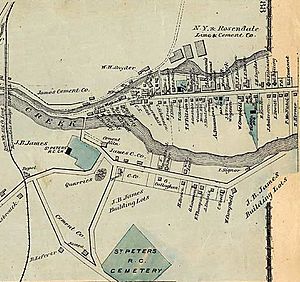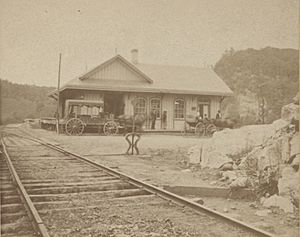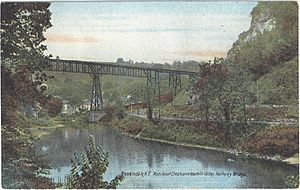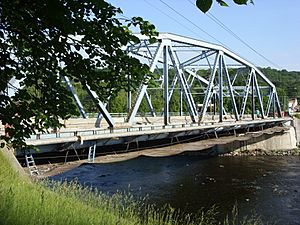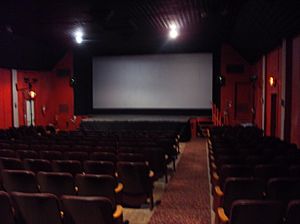Rosendale (CDP), New York facts for kids
Quick facts for kids
Rosendale, New York
Rosendale Village, Rosendale Hamlet
|
|
|---|---|
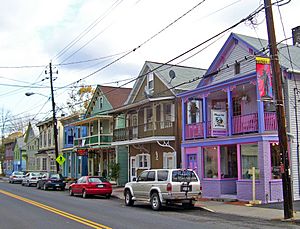
Restored period buildings along Main Street (NY 213)
|
|
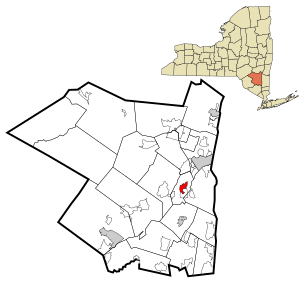
Location in Ulster County and the state of New York.
|
|
| Country | United States |
| State | New York |
| Region | Hudson Valley |
| County | Ulster County |
| Town | Town of Rosendale |
| Settled | 1680 |
| Incorporated | 1890 |
| Dissolved | December 31, 1977 |
| Government | |
| • Type | Unincorporated |
| Area | |
| • Total | 2.00 sq mi (5.19 km2) |
| • Land | 1.95 sq mi (5.04 km2) |
| • Water | 0.06 sq mi (0.14 km2) |
| Elevation | 131 ft (40 m) |
| Population
(2020)
|
|
| • Total | 1,285 |
| • Density | 659.99/sq mi (254.81/km2) |
| Time zone | UTC-5 (Eastern (EST)) |
| • Summer (DST) | UTC-4 (EDT) |
| ZIP Code |
12472
|
| Area code(s) | 845 |
| FIPS code | 36-63742 |
| GNIS feature ID | 2389777 |
| Exchanges | 658 |
Rosendale is a small community in Ulster County, New York. It is known as a hamlet, which is a small settlement without its own local government. It is also a census-designated place, meaning the U.S. Census Bureau counts its population. In 2020, about 1,285 people lived here.
Rosendale began as a settlement in the late 1600s. It grew a lot after a special type of building material, called Rosendale cement, was found nearby in 1825. This cement was used to build many famous landmarks across the United States. The Delaware and Hudson Canal and later the Wallkill Valley Railroad helped Rosendale's economy boom.
However, the village faced tough times. A big fire in 1895 destroyed many buildings. Over time, the demand for Rosendale cement decreased, causing economic struggles. Floods also hit the area hard. In 1976, the people of Rosendale voted to dissolve their village government. This meant it became part of the larger Town of Rosendale and no longer had its own mayor or village rules.
After its dissolution, artists and business owners helped bring new life to Rosendale's Main Street. Today, Rosendale is famous for its lively street festivals. It is also home to important landmarks like the Rosendale trestle, a former railroad bridge now used as a walking path, and Joppenbergh Mountain.
Contents
Rosendale's Past: A Look at Its History
Early Days and First Settlers
Long ago, Native Americans lived in the Rosendale area, near a spring. The first European settler was Jacob Rutsen, a merchant from Albany. In 1677, he bought land from a local Native American named Anckerop. Anckerop agreed to the sale, but he wanted to keep planting corn there and have Rutsen plow his fields.
In 1680, Dirck Keyser leased land from Rutsen and built the very first house in Rosendale. It was a stone house at the base of what is now Joppenbergh Mountain. More land was bought from the Esopus tribe in 1682. By 1700, the settlement was called "Rosendall" or "Roasendale." The name might come from the wild roses that grew in the area, or it could be a Dutch word. Jacob Rutsen, who died in 1730, is buried there and is known as the "Founder of Rosendale."
For many years, Rosendale remained a small place with only a few houses. This changed dramatically in 1825 when a special type of rock, used to make Rosendale cement, was discovered nearby.
The Cement Boom and Growth
The discovery of dolomite in 1825 was a huge deal for Rosendale. This rock was the largest natural cement deposit found in the United States. This cement was very important for building the Delaware and Hudson Canal, which helped transport goods. The cement industry quickly made Rosendale grow and become successful.
By 1835, Rosendale had a cement plant, a post office, a tavern, and several shops and homes. When the larger Town of Rosendale was formed in 1844, the village kept the same name. In 1871, the Wallkill Valley Railroad arrived, and the Rosendale trestle bridge was finished the next year. Rosendale's train station was the biggest on the Wallkill Valley line.
Rosendale cement was used in many famous buildings and structures across the country. These include the Brooklyn Bridge, the Washington Monument, Grand Central Terminal, and parts of the Statue of Liberty and the United States Capitol. At its busiest, Rosendale had many businesses and its cement industry employed 5,000 people, producing millions of barrels of cement each year.
Challenges and Changes
A big fire in 1895 destroyed half of Rosendale Village, burning 26 buildings. The village had no fire protection at the time. About 10,000 people came to see the damage after the fire. In 1900, the village tried to buy a water plant, but this led to legal issues.
By 1910, the canal that ran through Rosendale had closed. The village's economy also suffered as a new type of cement, Portland cement, became more popular. Rosendale's population dropped a lot between 1900 and 1920. In 1923, the Rosendale train station was also destroyed by fire.
Rosendale experienced severe floods in 1928, 1936, and 1955. Floodwaters reached the first floors of buildings on Main Street. The federal government later approved money for flood control projects, including changing the shape of the Rondout Creek and raising parts of Main Street. These projects helped prevent future extreme floods.
In the 1970s, the last cement plant in Rosendale closed. The abandoned cement mines were then used for growing edible mushrooms and for storing records. One large storage facility, operated by Iron Mountain Incorporated, was built inside the old limestone caves. It was designed to be very secure and could even withstand a "direct atomic hit" on a nearby city.
The Village Dissolves
By the 1970s, Rosendale Village faced many problems, including high taxes and issues with its water and sewer systems. The village government and the town government often disagreed.
In 1975, Raivo Puusemp, an artist and teacher, became mayor. He believed that dissolving the village government was the best way to solve its problems. He saw this political process as a form of conceptual art. After much discussion, the villagers voted to dissolve the village in March 1976.
Puusemp resigned as mayor and moved away. Marc Phelan became the last mayor of Rosendale Village. On January 1, 1978, Rosendale officially became disincorporated, meaning it no longer had its own separate village government. It became fully part of the larger Town of Rosendale.
Modern Rosendale: A New Beginning
After the village dissolved, taxes for former village residents went down. Artists and business owners helped to bring new life to the old Main Street buildings that had fallen apart. They bought and fixed up these properties, turning them back into shops and businesses.
The Century House Historical Society was formed in 1991 to preserve the history of the Rosendale cement industry. They have a museum and hold events. One interesting place is the Widow Jane Mine, a former cement mine that has hosted concerts, poetry readings, and other events.
Rosendale is now known for its fun annual festivals. The Rosendale Street Festival in July celebrates local talent. Since 1998, Rosendale has held an annual pickle festival, which attracts thousands of visitors. There is also a winter festival called "Frozendale" and even a zombie-themed festival. These events bring many people to Rosendale each year.
Rosendale's Location and Landscape
Rosendale Village covers about 1.96 square miles (5.08 square kilometers). Most of this is land, with a small amount of water. It is located in the middle of the Town of Rosendale, right next to the Rondout Creek. The creek sometimes floods, especially after heavy rains.
The hamlet is bordered by the creek and by Joppenbergh Mountain, which is about 495 feet (151 meters) tall. Main roads like NY 32 and NY 213 pass through Rosendale. It is about 2 miles (3.2 km) east of High Falls and 8 miles (12.9 km) south of Kingston.
The land under Rosendale has different layers of rock that formed millions of years ago. These layers include shale, sandstone, and limestone. The limestone contains the dolomite rock that was mined for natural cement. The area was also shaped by glaciers during the last ice age, which left behind deposits of soil and rock.
Rosendale's Weather
Rosendale gets about 44 inches (112 cm) of rain and snow each year. May is usually the wettest month. July is the warmest month, with temperatures sometimes reaching over 100 degrees Fahrenheit (38 degrees Celsius). January is the coldest month, and temperatures can drop to -30 degrees Fahrenheit (-34 degrees Celsius).
| Climate data for Rosendale, New York | |||||||||||||
|---|---|---|---|---|---|---|---|---|---|---|---|---|---|
| Month | Jan | Feb | Mar | Apr | May | Jun | Jul | Aug | Sep | Oct | Nov | Dec | Year |
| Record high °F (°C) | 68 (20) |
73 (23) |
86 (30) |
94 (34) |
96 (36) |
99 (37) |
103 (39) |
100 (38) |
101 (38) |
88 (31) |
82 (28) |
72 (22) |
103 (39) |
| Mean daily maximum °F (°C) | 34 (1) |
38 (3) |
47 (8) |
59 (15) |
70 (21) |
78 (26) |
84 (29) |
82 (28) |
74 (23) |
62 (17) |
51 (11) |
39 (4) |
60 (16) |
| Mean daily minimum °F (°C) | 15 (−9) |
16 (−9) |
26 (−3) |
36 (2) |
46 (8) |
55 (13) |
60 (16) |
59 (15) |
50 (10) |
38 (3) |
30 (−1) |
21 (−6) |
38 (3) |
| Record low °F (°C) | −30 (−34) |
−23 (−31) |
−13 (−25) |
13 (−11) |
27 (−3) |
35 (2) |
43 (6) |
38 (3) |
26 (−3) |
18 (−8) |
3 (−16) |
−23 (−31) |
−30 (−34) |
| Average precipitation inches (mm) | 3.19 (81) |
2.53 (64) |
3.59 (91) |
3.79 (96) |
4.73 (120) |
3.73 (95) |
4.72 (120) |
3.83 (97) |
3.69 (94) |
3.56 (90) |
3.53 (90) |
3.23 (82) |
44.12 (1,120) |
| Source: The Weather Channel | |||||||||||||
Important Places in Rosendale
Churches of Rosendale
Rosendale Village once had four churches: a Baptist, Dutch Reformed, Catholic, and Episcopal church. Today, only the Catholic church is still used for services.
The Baptist church was built in 1842. It closed in 1929 and was later used as a house and a theater. Sadly, it burned down in 2004. The Dutch Reformed church was built in 1843 and rebuilt after a fire in 1895. In 1985, it was turned into a glass studio called Belltower Lighting.
The Catholic Church of St. Peter was first built in 1850. A larger, more beautiful church was built in 1876 in the English Gothic architecture style. This church is the only one of Rosendale's original churches that is still active.
The Episcopal church, All Saints' Chapel, was built in 1876. It was badly damaged by floods in 1955 and later bought to become the Rosendale Library. The library building was damaged by fire in 1975 but was restored and expanded. In 1986, it was added to the National Register of Historic Places.
Joppenbergh Mountain: A Local Landmark

Joppenbergh Mountain is a 495-foot (151-meter) mountain next to the village. It was named after Jacob Rutsen, Rosendale's founder. In the late 1800s, people mined the mountain for dolomite, which was used to make cement. In 1899, a large cave-in happened, but luckily, no miners were hurt because they were outside eating lunch.
In the late 1930s and early 1940s, Joppenbergh Mountain was used for skiing competitions. Skiing returned in the 1960s and continued until 1971. In 2011, the Open Space Institute bought the mountain and plans to sell it to the town, possibly for public use.
The Rosendale Trestle Bridge
Construction of a railroad bridge over the Rondout Creek began in 1870. This bridge, known as the Rosendale trestle, officially opened in 1872. It was a very tall bridge, and some people worried if it was strong enough. The bridge was rebuilt with steel in the late 1890s and reinforced many times.
When the railroad line closed in 1977, the bridge was no longer used for trains. In 1986, it was sold for just one dollar to a businessman who wanted to use it for bungee jumping. However, this plan was stopped by local rules. In 2009, the county took over the bridge, and it was sold to an environmental group. After repairs, the trestle reopened in 2013 as a walking path, part of the Wallkill Valley Rail Trail.
Route 32 Bridge
During the American Revolution, General George Clinton crossed the Rondout Creek at Rosendale in 1777. Today, a bridge on State Route 32 stands at that spot. The bridge was built around 1934 and has been updated several times, most recently in 2008-2009. This renovation cost $5.5 million. There is also a park and ride lot nearby, served by local bus services.
Rosendale Theatre
The Rosendale Theatre started as a casino in the 1920s. In 1949, it was turned into a movie theater by Anthony Cacchio. His son, Anthony Cacchio Jr., later ran the theater and even banned popcorn in 1969!
In 2010, a group formed a nonprofit organization to save the theater from being sold. They bought the building and have made many improvements, including a new digital projector and sound system. They plan to add a concession stand and move the ticket booth outside. In 2011, the theater received a state grant to help with renovations.
Rosendale's Population
| Historical population | |||
|---|---|---|---|
| Census | Pop. | %± | |
| 1890 | 1,706 | — | |
| 1900 | 1,840 | 7.9% | |
| 1910 | 1,125 | −38.9% | |
| 1920 | 555 | −50.7% | |
| 1930 | 539 | −2.9% | |
| 1940 | 671 | 24.5% | |
| 1950 | 885 | 31.9% | |
| 1960 | 1,033 | 16.7% | |
| 1970 | 1,220 | 18.1% | |
| 1980 | 1,134 | −7.0% | |
| 1990 | 1,284 | 13.2% | |
| 2000 | 1,374 | 7.0% | |
| 2010 | 1,349 | −1.8% | |
| 2020 | 1,285 | −4.7% | |
| Sources: 1890, 1900–1920, 1930–1950, 1960–1970, 1980, 1990, 2000, 2010 |
|||
In 2000, Rosendale had 1,374 people living in 602 households. About 25% of households had children under 18. The average household had 2.27 people. The population was spread out in terms of age, with many people between 25 and 44 years old. The median age was 39 years.
The average income for a household in Rosendale in 2000 was $34,712. About 8.2% of the population lived below the poverty line.
Education in Rosendale
Most of Rosendale is part of the Rondout Valley Central School District. A smaller part is in the Kingston City School District, which includes Kingston High School.
The Roman Catholic Archdiocese of New York used to run Catholic schools in Ulster County. St. Peter's School in Rosendale closed in 2001.
See also
 In Spanish: Rosendale Village para niños
In Spanish: Rosendale Village para niños


